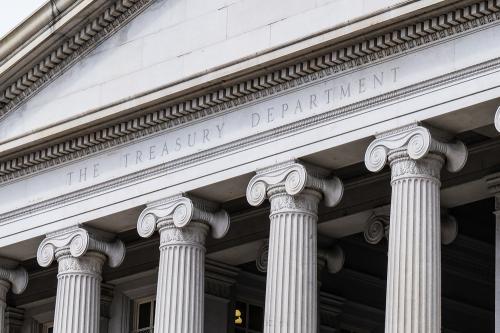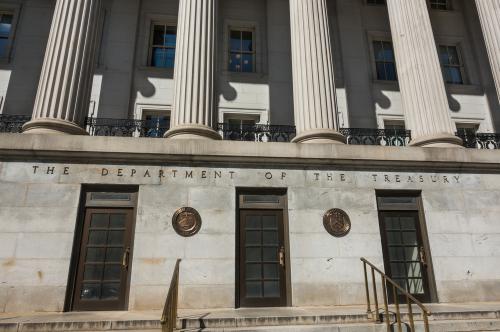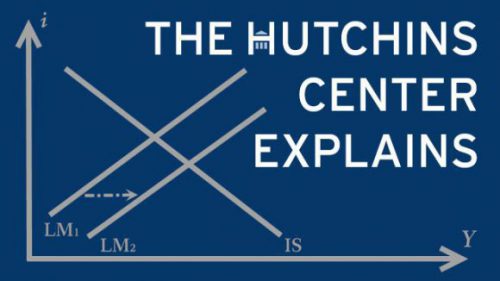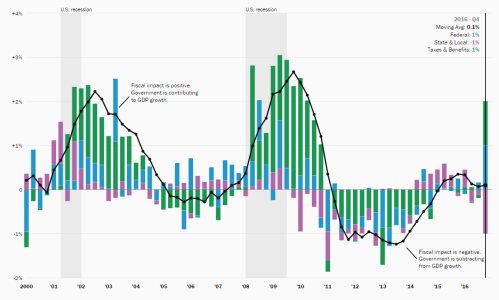Occasionally, one hears suggestions that a debt-ceiling showdown that leaves the Treasury without enough cash to pay all its bills will resemble a government shutdown, which has occurred several times in recent memory when Congress has failed to pass appropriation bills on time. This post explains the difference.
What is the debt ceiling?
When the federal government runs a deficit—that is, spends more than it collects in revenue—it borrows money to cover the difference by issuing IOUs in the form of U.S. Treasury securities. The debt ceiling is a limit, set by Congress, on the amount of borrowing the Treasury can do, currently $31.4 trillion. The Treasury hit that ceiling in January 2023 and has been taking what are known as “extraordinary measures” to keep paying the bills. But it will run out of maneuvering room sometime in the next several months, perhaps as early as June 2023, unless Congress acts.
(For more on the debt ceiling, see “What is the federal debt ceiling?” and “How worried should we be if the debt ceiling isn’t lifted?”.)
What happens in a government shutdown?
Under the Antideficiency Act (initially passed in 1884 and amended in 1950), federal agencies cannot spend or obligate any money without an appropriation (or other approval) from Congress. When Congress fails to enact the 12 annual appropriation bills, federal agencies must cease all non-essential functions until Congress acts. This is known as a government shutdown. During shutdowns, many federal employees are told not to report for work. Government employees who provide what are deemed essential services, such as air traffic control and law enforcement, continue to work, but don’t get paid until Congress takes action to end the shutdown. All this applies only to the roughly 25% of federal spending subject to annual appropriation by Congress. Benefits such as Social Security continue to flow because they are authorized by Congress in laws that do not need annual approval (although the services offered by Social Security benefit offices may be limited during a shutdown). In addition, the Treasury can continue to pay interest on U.S. Treasury debt on time.
There have been four shutdowns where operations were affected for more than one business day. In 1995-1996, President Clinton and the Republican Congress were unable to agree on spending levels, so the government shut down twice, for a total of 26 days. In 2013, a standoff over funding for the Affordable Care Act resulted in a 16-day shutdown. And in December 2018 and January 2019, a dispute over border wall funding led to a shutdown that lasted 35 days; it was a partial shutdown because Congress had previously passed five of the 12 appropriation bills. (For more on shutdowns, see the Committee for a Responsible Federal Budget’s FAQ.)
Shutdowns can be disruptive, leading to delays in processing applications for passports, small business loans, or government benefits; shuttered visitor centers and bathrooms at national parks; fewer food-safety inspections, and various inconveniences. But shutdowns are now sufficiently likely that the White House Office of Management & Budget posts the contingency plans that government agencies maintain for shutdowns. In short, members of Congress, government employees, financial markets, and the press generally understand what happens when a failure to pass appropriations bills leads to a government shutdown.
So how is that different from a failure to raise the debt ceiling?
Because tax revenues aren’t sufficient to cover all federal spending, the federal government borrows a lot—an average of more than $7 billion per business day. Raising the debt ceiling doesn’t increase federal spending beyond what already has been approved by Congress; it simply allows the government to pay for purchases and obligations it already has made.
Because Congress in the past has always lifted the debt ceiling before the Treasury has run out of money, no one knows for sure what will happen if Congress doesn’t act this time—what the Treasury and the Federal Reserve will do, and how financial markets will react. Failure to make timely interest and principal payments on U.S. Treasury securities, regarded as the safest financial asset in the world, would be an unprecedented default and, among other things, would call into question the credibility of the U.S. government’s promises and probably raise the interest rate that investors demand to hold U.S. Treasury debt in the future.
In contrast to government shutdowns, a failure to raise the debt ceiling threatens not only the spending subject to annual appropriation by Congress, but all federal spending—including interest on the debt and Social Security, Medicare, and other government benefits. Federal employees can continue working—there is no need for agencies to decide which services are essential and which are not—but their paychecks may be delayed.
We know from transcripts of Federal Reserve meetings that when this issue arose in 2011, the Obama Treasury was planning to make all interest and principal payments and to delay paying all its other bills—including government benefits. The Biden Treasury hasn’t said what it plans to do if Congress doesn’t raise the debt ceiling in time. It is, however, likely to make interest and principal payments on Treasury debt. Whether and how it will prioritize other payments is unclear—but someone will not get paid on time; there simply won’t be enough cash to meet every obligation.
What is the connection between raising the debt ceiling and reducing the federal deficit?
Legally, there is no connection, though sometimes the two issues occur close together if the Treasury bumps up against the debt ceiling close to the end of the federal fiscal year on September 30, the deadline for approving appropriations bills (even if only temporary ones).
Still, members of Congress have used the imperative of raising the debt ceiling as leverage in negotiations in Congress and with the White House over appropriation bills and, sometimes, over broader tax and spending policies. (This maneuver usually is used by members of Congress from a party other than the president’s party.) In 2011, for instance, President Obama and the Republican majority in the House reached a multi-part agreement—the Budget Control Act—just a couple of days before the Treasury ran out of cash. Among other things, it put caps on total appropriated spending and created a special congressional committee to craft a plan to reduce future deficits. The committee failed to come to agreement, triggering a series of automatic spending cuts.
The Brookings Institution is financed through the support of a diverse array of foundations, corporations, governments, individuals, as well as an endowment. A list of donors can be found in our annual reports published online here. The findings, interpretations, and conclusions in this report are solely those of its author(s) and are not influenced by any donation.







Commentary
What’s the difference between a government shutdown and a failure to raise the debt ceiling?
April 24, 2023